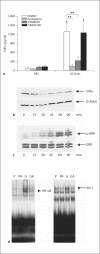German cockroach frass proteases modulate the innate immune response via activation of protease-activated receptor-2
- PMID: 20588004
- PMCID: PMC2968762
- DOI: 10.1159/000317195
German cockroach frass proteases modulate the innate immune response via activation of protease-activated receptor-2
Abstract
Allergen exposure can induce an early innate immune response; however, the mechanism by which this occurs has not been addressed. In this report, we demonstrate a role for the active serine proteases in German cockroach (GC) feces (frass) and protease-activated receptor (PAR)-2 in modulating the innate immune response. A single exposure of GC frass induced inflammatory cytokine production and cellular infiltration in the airways of mice. In comparison, exposure to protease-depleted GC frass resulted in diminution of inflammatory cytokine production and airway neutrophilia, but had no effect on macrophage infiltration. Selective activation of PAR-2 confirmed that PAR-2 was sufficient to induce airway inflammation. Exposure of GC frass to PAR-2-deficient mice led to decreased immune responses to GC frass compared to wild-type mice. Using the macrophage as an early marker of the innate immune response, we found that GC frass induced significant release of tumor necrosis factor-alpha from primary alveolar macrophages. This effect was dependent on the intrinsic proteases in GC frass. We confirmed GC frass-induced cytokine expression was mediated by activation of NF-kappaB and ERK in a macrophage cell line. Collectively, these data suggest a central role for GC frass protease-PAR-2 activation in regulating the innate immune response through the activation of alveolar macrophages. Understanding the potential role of protease-PAR-2 activation as a danger signal or adjuvant could yield attractive therapeutic targets.
2010 S. Karger AG, Basel.
Figures





Similar articles
-
Role of cockroach proteases in allergic disease.Curr Allergy Asthma Rep. 2012 Oct;12(5):448-55. doi: 10.1007/s11882-012-0276-1. Curr Allergy Asthma Rep. 2012. PMID: 22644866 Review.
-
Mucosal sensitization to German cockroach involves protease-activated receptor-2.Respir Res. 2010 May 24;11(1):62. doi: 10.1186/1465-9921-11-62. Respir Res. 2010. PMID: 20497568 Free PMC article.
-
German cockroach proteases and protease-activated receptor-2 regulate chemokine production and dendritic cell recruitment.J Innate Immun. 2012;4(1):100-10. doi: 10.1159/000329132. Epub 2011 Aug 29. J Innate Immun. 2012. PMID: 21876326 Free PMC article.
-
Protease-activated receptor 2 activation of myeloid dendritic cells regulates allergic airway inflammation.Respir Res. 2011 Sep 21;12(1):122. doi: 10.1186/1465-9921-12-122. Respir Res. 2011. PMID: 21936897 Free PMC article.
-
Cockroach allergen exposure and risk of asthma.Allergy. 2016 Apr;71(4):463-74. doi: 10.1111/all.12827. Epub 2016 Feb 4. Allergy. 2016. PMID: 26706467 Free PMC article. Review.
Cited by
-
Airborne indoor allergen serine proteases and their contribution to sensitisation and activation of innate immunity in allergic airway disease.Eur Respir Rev. 2024 Apr 24;33(172):230126. doi: 10.1183/16000617.0126-2023. Print 2024 Apr 30. Eur Respir Rev. 2024. PMID: 38657996 Free PMC article. Review.
-
The role of protease-activated receptor-2 on pulmonary neutrophils in the innate immune response to cockroach allergen.J Inflamm (Lond). 2012 Sep 6;9(1):32. doi: 10.1186/1476-9255-9-32. J Inflamm (Lond). 2012. PMID: 22954301 Free PMC article.
-
Role of cockroach proteases in allergic disease.Curr Allergy Asthma Rep. 2012 Oct;12(5):448-55. doi: 10.1007/s11882-012-0276-1. Curr Allergy Asthma Rep. 2012. PMID: 22644866 Review.
-
The New Paradigm: The Role of Proteins and Triggers in the Evolution of Allergic Asthma.Int J Mol Sci. 2024 May 25;25(11):5747. doi: 10.3390/ijms25115747. Int J Mol Sci. 2024. PMID: 38891935 Free PMC article. Review.
-
β-Arrestin-biased proteinase-activated receptor-2 antagonist C781 limits allergen-induced airway hyperresponsiveness and inflammation.Br J Pharmacol. 2023 Mar;180(5):667-680. doi: 10.1111/bph.15903. Epub 2022 Dec 5. Br J Pharmacol. 2023. PMID: 35735078 Free PMC article.
References
-
- Kheradmand F, Kiss A, Xu J, Lee SH, Kolattukudy PE, Corry DB. A protease-activated pathway underlying Th2 cell type activation and allergic lung disease. J Immunol. 2002;169:5904–5911. - PubMed
-
- Sudha VT, Arora N, Singh BP. Serine protease activity of Per a 10 augments allergen-induced airway inflammation in a mouse model. Eur J Clin Invest. 2009;39:507–516. - PubMed
-
- Tripathi P, Kukreja N, Singh BP, Arora N. Serine protease activity of Cur 11 from Curvularia lunata augments Th2 response in mice. J Clin Immunol. 2009;29:292–302. - PubMed
Publication types
MeSH terms
Substances
Grants and funding
LinkOut - more resources
Full Text Sources
Other Literature Sources
Medical
Miscellaneous

